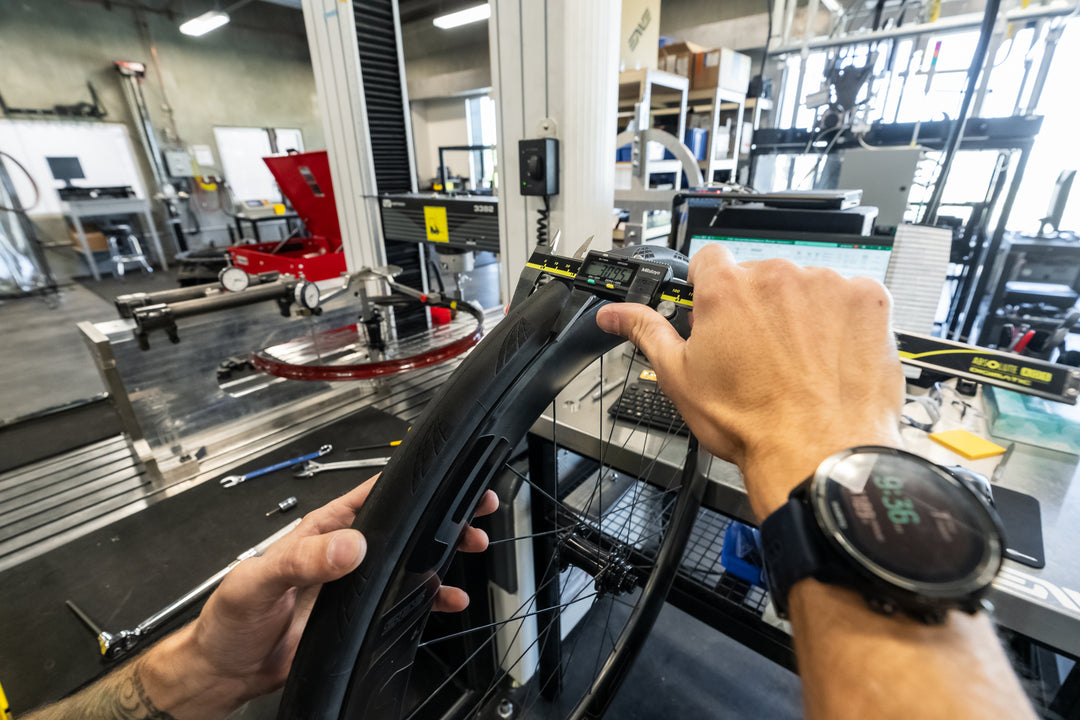Building a Faster Wheel
BUILDING A FASTER WHEEL
JANUARY 13TH, 2015
In designing ENVE carbon fiber wheels, our engineers set out to produce the fastest wheels on the planet. “FAST” lives at the intersection of stiffness, lightness and durability. All of these factors contribute to the characteristics of the way a wheel rides. Each piece of the puzzle must be carefully balanced to create the best experience. Anyone can make a stiff, durable, heavy wheel. And most can make a light wheel that isn’t durable. However, combining all three is the real engineering challenge.

There are several factors that contribute to making a wheel that meets all of these criteria. Carbon fiber is unique in the fact that it allows for fine tuning in the layup process defining the ride quality and characteristics of the wheel, but the final touches and fine tuning are honed in the wheel build process. All the components of the wheel build itself can be tailored to compliment the attributes that are hand crafted into every ENVE rim.
The art of the wheel build begins with a rim and hub, joined by spokes and nipples woven in a precise pattern. The rim spoke face, hub flange diameter, hub flange spacing, spoke type, nipple type, and lacing pattern each play a part in the nuances of the wheel’s final characteristics. Every hand-built ENVE wheel balances these elements in order to optimize stiffness, weight, and strength.
WHEEL STIFFNESS DEFINED
When referring to wheels, the word “stiffness” is often thrown around, but what does stiffness actually refer to? Wheel stiffness is defined by three categories torsional, vertical, and lateral. Each one of these components of stiffness is important to discuss when deciding the optimal lacing pattern for each application.

TORSIONAL STIFFNESS
Torsional stiffness refers to the amount of twist of the rim in relation to the hub about the hub axle. Sometimes referred to as windup, this type of stiffness is felt in the rear wheel during hard acceleration, or in both the front and rear wheel under hard braking when using disc brakes. In fact, torsional stiffness is only a factor when torque is transferred from the hub to the rim or vice versa.
VERTICAL STIFFNESS
Vertical stiffness refers to the amount the wheel deflects during vertical loading. Being the opposite of vertical compliance, this type of stiffness is felt when encountering a bump on the road or trail or just by sitting on the bike. Since vertical compliance is generally desired for a more comfortable and damping ride, a wheel that is too vertically stiff will ride harsh and unforgiving.
LATERAL STIFFNESS
Lateral stiffness prevents the wheel from deflecting sideways under lateral loading. This type of loading occurs while pedaling and cornering. Of the three types of stiffness, lateral stiffness has the most noticeable effect on the ride quality.
LACING PATTERN: RADIAL, 2-CROSS, AND 3-CROSS
The most common lacing patterns for mountain, road, and cyclocross wheels are radial, 2-cross and 3-cross. Each pattern affects the stiffness, strength and weight respectively. These attributes are somewhat interdependent and as with most things there are tradeoffs, increasing stiffness can decrease strength and increasing strength can increase weight. The best solution is one that provides an “ideal” balance. While many argue over what “ideal” means, the wheel build for ENVE is an optimal balance between stiffness, weight, and strength, complimenting the engineered design of the carbon fiber rim.
A combination of lacing patterns may be used for a specific wheel build, but there are some restrictions when it comes to selecting a lacing pattern. For example, if torque is transferred through the hub under pedaling load and/or under disc brake load, a radial lacing pattern should only be considered for one side of a disc wheel and/or rear wheel assuming the opposing side uses a cross pattern to accommodate the drive and braking forces.
Our hand crafted rims are designed with damping quality, aerodynamics, and durability in mind, each wheel set’s lacing pattern has been applied to suit the application best.

RADIAL LACING
ENVE uses a radial lacing pattern on front non-disc road wheels because it provides the best lateral stiffness and allows for precise cornering and control. Because there are not large amounts of torque being transmitted through the hub, the radial lacing pattern also effectively reduces the weight of the wheel because it allows for use of the shortest spokes.

2-CROSS LACING
The most commonly seen lacing pattern on ENVE wheels is 2-cross. Featured on all non-disc rear road wheels, and all mountain wheels, this pattern compliments the hand-tuned carbon rim with a premium balance in stiffness, weight, and strength. The 2-cross pattern maintains lateral stiffness, yet it allows the wheel to comply and dampen well under impact, while managing the torque generated from the disc brakes and drivetrain.

3-CROSS LACING
ENVE chose a 3-cross lacing pattern for the 3.4 road disc wheels to balance the torque generated by the disc brakes with a lower 24-hole spoke count, giving the wheel the best balance between torsional and lateral stiffness as well as vertical compliance.
J-BEND SPOKES
The trusty j-bend spoke is our go-to choice for wheel building because it offers convenience in serviceability, and freedom in lacing pattern choice. Spokes are a very vulnerable component in the wheel system, so when an unexpected circumstance leaves you with a broken spoke, a repair shop is most likely going to have a spoke you can use. J-bend spokes also give ENVE the option to tailor the lacing pattern to best compliment the desired ride quality of a wheel set. This is advantageous in optimizing the performance of every ENVE wheel set.
SUMMARY
The ENVE wheel build addresses one piece of the puzzle in optimizing the ride of each ENVE wheel set. By selecting the right lacing pattern, spoke tensions, hole counts and materials, we ensure that no matter which ENVE wheel you select, you’ll be going faster.




